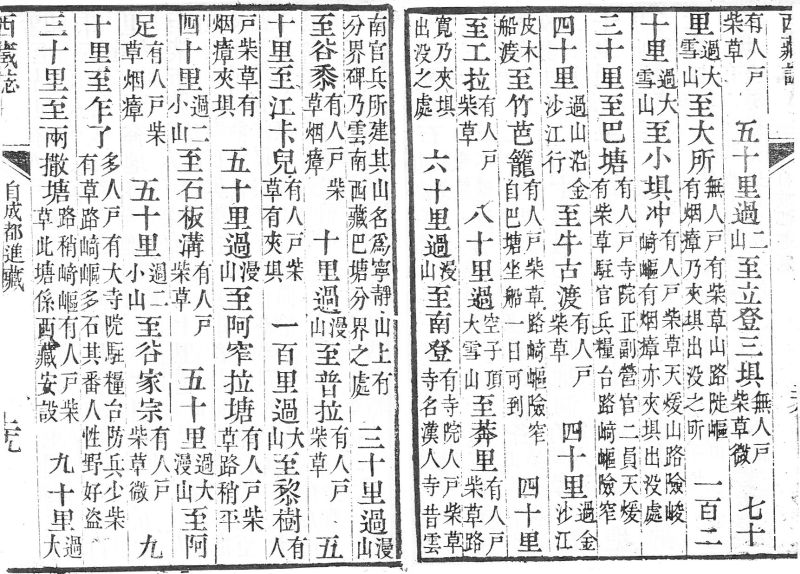Xizang zhi 西藏志, occasionally called Xizang ji 西藏記, is a report on Tibet written by an anonymous author in the late 18th century. A preface written by Hening 和寧 (Heying 和瑛, 1741-1821) in 1792 said it was compiled by the Prince Guo 果親王, who is usually identified with Prince Guoyi 果毅親王, called Yūnli 允禮 (d. 1738). Some scholars believe the author was Xiao Tenglin 蕭騰麟, who wrote the book Xizang jianwen lu 西藏見聞錄. Zhang Yuxin 張羽新 is even proved that the texts of the two books are identical (Wang & Fu 1991).
Some editions, like the series Zhongguo bianjiang congshu 中國邊疆叢書 and Zhongguo xinan wenxian congshu 中國西南文獻叢書 (part Xinan xijian fangzhi wenxian 西南稀見方誌文獻), indicate that the author was Jiao Yingqin 焦應旂, yet he might just have been the author of the postal station list Zangcheng jilüe 藏程紀略 which in some editions opens the text, while it constitutes an appendix in others.
The book goes back into history, when Tibet (Tubo 吐蕃) was a powerful kingdom, and ends in 1721. It includes information not just ob Tibet proper, but also on the adjacent territories of Qinghai (Köke Nur) and Sichuan. Some information deviates from other sources. The conquest of Batang 巴塘 by Yang Shilu 楊世祿 (d. 1640), for instance, is described differently as in the book Xiyu shuji 西域述記 by Li Juyuan 李菊園. The author quotes the most important inscriptions on Tibet, like the stele asserting the treaty of 823 between the Tang 唐 (618-907) emperor Muzong 唐穆宗 (r. 820-824) and the king of Tibet, Tritsug Detsen (r. 815-841), or the stele erected by the Kangxi Emperor 康熙帝 (r. 1661-1722) commemorating his victory over Gushri Khan (Qing Shengzu yuzhi pingding Xizang beiwen 清聖祖御制平定西藏碑文, 1724), the stele of the Qianlong Emperor 乾隆帝 (r. 1736-1795) praising his ten accomplished wars (Qianlong yuzhi shiquan ji bei 乾隆御制十全記碑, 1792) steles erected by general Karbi 噶爾弼 (d. 1727), Nian Gengyao 年羹堯 (1679-1726), Jalangga 查郎阿 (c. 1690-1747) or Ma Jishi 馬紀師.
 |
The list gives the distance between stations, particular features of the way ("two mountains", "upwards", "down", "along a river", and the like), and the situation of the station, for instance, "few houses", "no houses", "grass and firewood available", or "a few troops in a military post, and a large monastery". |
The book was first printed in 1792 by Hening, at that time amban (resident minister) in Tibet (Xizang banshi dachen 西藏辦事大臣)), is called (Qianlong) Xizang zhi (乾隆)西藏志. The book consists of 35 chapters dealing with the history, geography, religion, economy, administration and culture of Tibet. The focus of the chapter History (Shiji 事跡) is the conquest of Tibet by the Qing army to subdue the Dzunghar leader Tsewang Arabdan 策妄阿拉布坦 (1665-1727), the politics of the four prime ministers (kalön, Ch. galun 噶倫), the pacification of Qinghai and the escape of the Qošod (Heshuote 和碩特) leader Lobsang Tandzin 羅卜藏丹津 (1682-?) to Tibet in 1723, and the rebellion of minister Ngaphöpa Dorje Gyalpo (Ch. Arbuba 阿爾布巴) against chief minister Khangchenné (Ch. Kangjinai 康濟鼐 d. 1727).
There is an appendix called Zangcheng jilüe 藏程紀略 giving information on the courier routes to central Tibet. The Xizang zhi was an important source for later books on Tibet, like Xizang tushuo 西藏圖說 or Wei-Zang tongzhi 衛藏通志.
The book is included in the series Zhongguo minzu shi-di ziliao congkan 中國民族史地資料叢刊 and Zangzu yanjiu congkan 西藏研究叢刊. In 1982, Wu Fengpei 吳豐培 published a modern, annotated edition.
| 事跡 | Shiji | History |
| 疆圉 | Jiangyu | Geography |
| 山川 | Shanchuan | Mountains and rivers |
| 寺廟 | Simiao | Monasteries |
| 天時 | Tianshi | Weather |
| 物產 | Wuchan | Local products |
| 歲節 | Suijie | Seaons and agriculture |
| 紀年 | Jinian | Calendar |
| 風俗 | Fengsu | Customs and habits |
| 衣冠 | Yiguan | Clothes |
| 飲食 | Yinshi | Food |
| 婚嫁 | Hunjia | Marriage |
| 夫婦 | Fufu | Matrimony |
| 生育 | Shengyu | Birth |
| 喪葬 | Sangzang | Funeral |
| 醫藥 | Yiyao | Medicine |
| 占卜 | Zhanbu | Divination |
| 禮儀 | Liyi | Rituals and ceremonies |
| 宴會 | Yanhui | Social gatherings |
| 市肆 | Shisi | Markets |
| 房舍 | Jushe | Houses |
| 刑法 | Xingfa | Penal law |
| 封爵 | Fengjue | Nobility |
| 頭目 | Toumu | Chieftains |
| 兵制 | Bingzhi | Military |
| 邊防 | Bianfang | Border defence |
| 征調 | Zhengdiao | Recruitment |
| 賦役 | Fuyi | Taxes and corvée |
| 朝貢 | Chaogong | Tributes |
| 外番 | Waifan | Barbarians outside of Tibet |
| 碑文 | Beiwen | Inscriptions on steles |
| 唐碑 | Tangbei | The Tang Stele |
| 臺站 | Taizhan | Courier stations |
| 糧站 | Liangzhan | Grain stations |
| 附錄 | Fulu | Appendix |
| 西藏志程站 | Xizangzhi chengzhan | List of relay stations to and in Tibet |
An updated gazetteer on Tibet was compiled by Xu Guangshi 許光世, courtesy name Jianhong 劍虹, and Cai Jincheng 蔡晉成, courtesy name Jianxiu 劍修, both hailing from Yanghu 陽湖 (today's Wujin 武進, Zhejiang). Their book is called (Xuantong) Xizang xinzhi (宣統)西藏新志 and has a length of 3 juan. It was finished in 1909 and was intended to serve the central government as a reliable document on Tibet. The text is divided into three parts, namely geography, politics, and history, with a few novel categories, namely posts and telecommunications (youdian 郵電), finance (caizheng 財政), commerce (shangwu 商務), and education (jiaoyu 教育). The book gives evidence of the growing trade with states in the south, namely Bhutan, Nepal, Sikkim, and Pakistan, who all stood under the influence of British India.
It was printed by the Shanghai Zizhi Bianji Press 上海自治編輯社 (自治社).